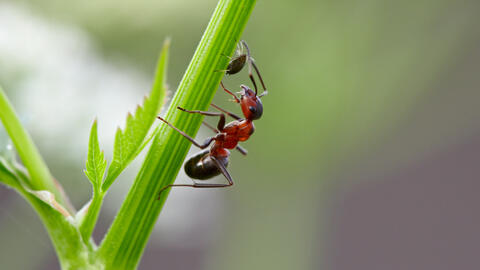Evicting And Combatting Ants
Ants are actually really useful creatures as they take on the role of the health police in nature. But unfortunately, they also have a few characteristics that can make life really difficult for hobby gardeners. Here’s how to fend off and combat ants if they become bothersome.

Describing ants as harmful animals is completely untrue - because these flying insects are extremely effective pest exterminators. The red forest ants (Formica rufa) primarily inhabit forest edges and glades and are a protected species. Each day, a forest ant colony grapples with up to 100,000 invertebrates. Although ants do not distinguish between beneficial insects and pests according to human criteria, numerous plant-eating insects such as caterpillars and leaf beetle larvae are still on the menu.
Yet ants have a few bad habits from a gardening perspective: They protect aphids against predators so they can harvest their sugar-rich excretions - the honeydew. Some species also have a predilection for building their nesting holes under sunny patios, because the paving stones warm up particularly quickly in the spring. And occasionally, ants munch on sweet, usually over-ripened fruit - although this damage is extremely limited.
There are two main species of ants in the garden: the black garden ant (Lasius niger) and the yellow meadow ant (Lasius flavus). The black garden ant is the more common species and is also often simply referred to as the garden ant.
An ant colony consists of up to 500 workers who generally grow to between 0.12 and 0.2 inches long. Black garden ants primarily feed on honeydew and aphids, scaly insects, , and cicidas, however, they are also predatory and prey on various species of insect. Garden ants have all but perfected aphid cultivation, even relocating the pests to other plants closer to their colony. The highly adaptable ants prefer to build their nests under paving stones and occasionally also intrude into houses.

At 0.01 to 0.12 inches, the yellow meadow ant is much smaller than the black garden ant. It prefers to build its nest under lawns and can dig up an earth mound the size of a mole hill. These are often only noticeable at a second glance, as they are frequently over grown with grass and only have a few exit tunnels. The yellow meadow ants stay in underground mealybug colonies and live almost entirely on the honeydew made by these insects. Which is also why these ants rarely leave their colony. A yellow meadow ant colony is usually founded by several queens. The queens later fight one another until only the strongest remains.

If the ants in your garden start to become annoying, you don’t have to fight them off straight away. In many cases, it is sufficient to simply relocate the creatures. You can do this by: placing a flower pot filled with wood shavings on the ant paths with the opening facing downwards and then simply waiting. After a while, the ants will begin to relocate their nest in the flower pot. You will notice when this happens because the insects will bring their pupae into the new abode. Wait until they have finished moving and then pick up the flowerpot with a shovel. The new location should be at least 30 meters away from the old nest, as otherwise the ants will return back to their former home.
Where possible, lay new patios and garden paths in such a way that they are not an attractive nesting place for ants. Avoid paving sand as a bedding for paving stones and use basalt chippings instead. You should also seal the joints with special paving joint mortar with an artificial resin basis. Products are now available that seal the paving surface against ants and weeds, but allow rainwater to permeate.

Ants do not like the scents and ethereal oils of various household remedies. These include lavender flowers, cinnamon, cloves, chili powder, and lemon peels. Simply spread these substances on ant nests and pathways. Chalk powder and garden lime are also proven ant barriers. You can simply spread a thin line in front of house entrances, for example, and apply an additional thick chalk layer to walls. The ants will not cross over the alkaline substances.
There are also household remedies for directly combatting ants. Stale beer with a tablespoon of honey mixed in has proven particularly effective. Simply pour it into a straight-sided bowl and position it on an ant path. The sweet scent entices in the ants and they fall into the liquid and drown. But beer also has a disadvantage - in addition to ants, it also magically attracts snails. Ants can be evicted from raised beds by heavily flooding the ant nest repeatedly with water.
Ants can also be combatted with baking powder - although you will also need to use it in conjunction with a sweet bait: If you mix the baking powder in a ratio of about 1:1 with powdered sugar, the ants will take interest and eat it. But afterwards, the creatures will die a really painful death.
